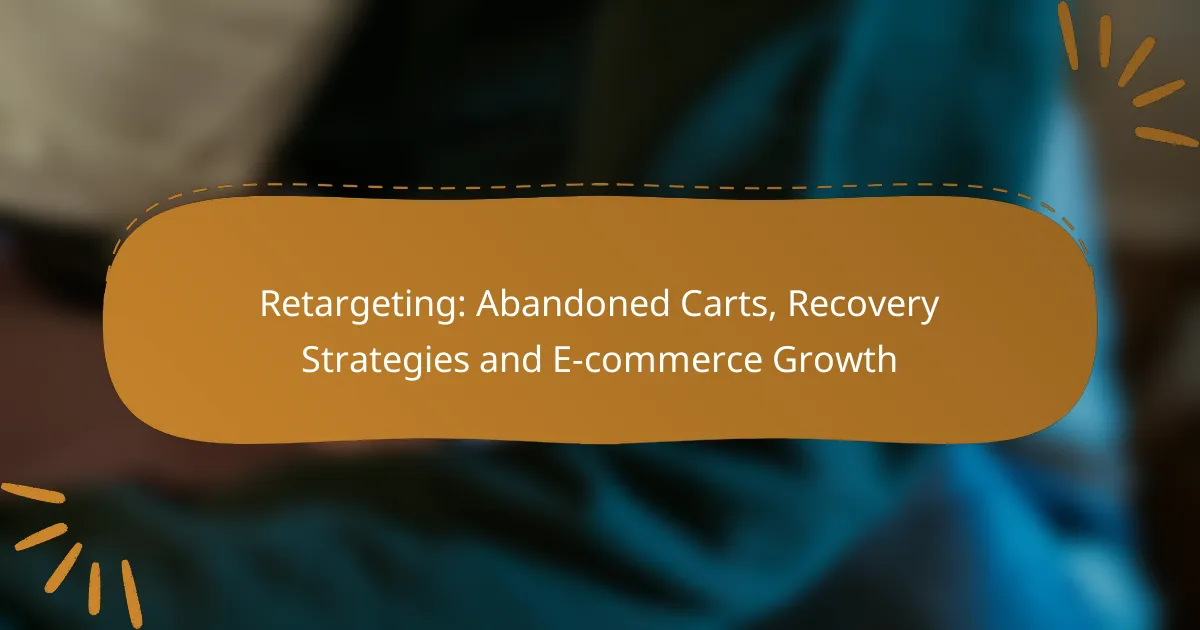Retargeting plays a crucial role in recovering abandoned carts by reminding potential customers of their unfinished purchases through targeted ads and communications. By utilizing user data, businesses can create personalized experiences that encourage shoppers to return and complete their transactions, ultimately driving e-commerce growth.
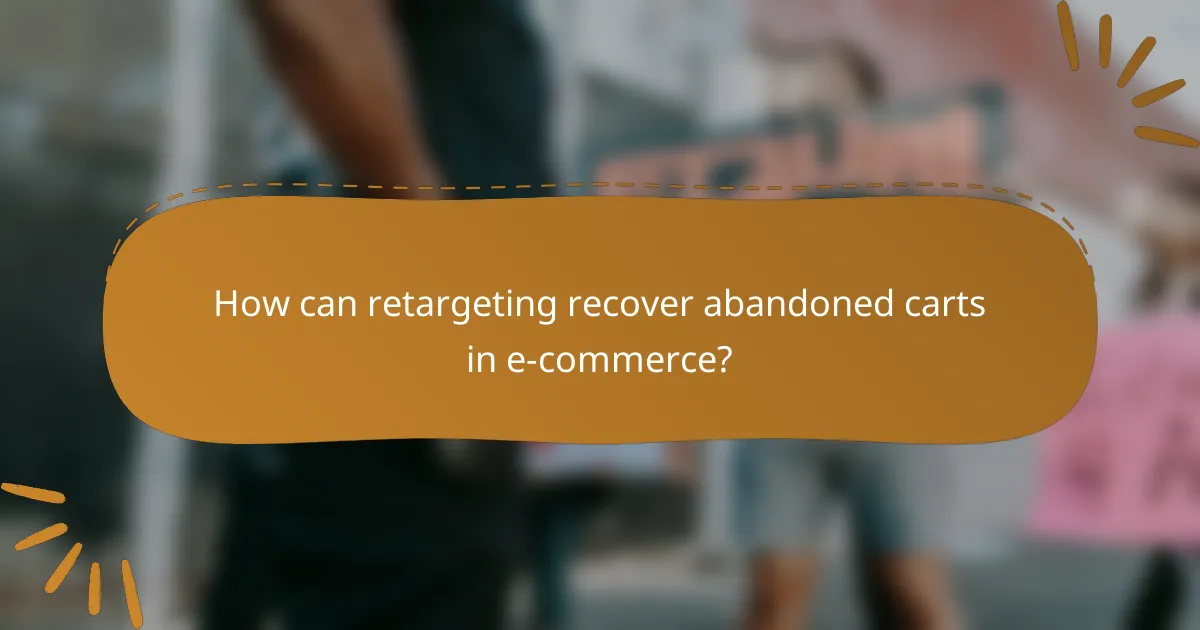
How can retargeting recover abandoned carts in e-commerce?
Retargeting can effectively recover abandoned carts by reminding potential customers of their unfinished purchases through targeted ads and communications. By leveraging user data, businesses can create personalized experiences that encourage shoppers to return and complete their transactions.
Dynamic ads for personalized recovery
Dynamic ads display products that users have previously viewed or added to their carts, making them highly relevant. These ads can be shown across various platforms, including social media and websites, ensuring that the products remain top-of-mind for potential buyers.
To implement dynamic ads, businesses should utilize retargeting platforms that allow for product catalog integration. This ensures that the ads are automatically updated with the latest inventory and pricing, providing a seamless experience for customers.
Email reminders for cart recovery
Email reminders serve as a direct way to reconnect with customers who have abandoned their carts. Sending a follow-up email within a few hours of abandonment can significantly increase the chances of recovery, as the products are still fresh in the customer’s mind.
These emails should include clear calls to action, product images, and links back to the cart. Personalization, such as addressing the customer by name and including specific items they left behind, can enhance engagement and drive conversions.
Incentives like discounts to encourage completion
Offering incentives, such as discounts or free shipping, can motivate customers to finalize their purchases. A small discount, typically ranging from 5% to 15%, can be enough to tip the scales in favor of completing the transaction.
It’s essential to communicate the value of these incentives clearly in retargeting ads and emails. However, businesses should be cautious not to over-rely on discounts, as this can devalue the brand and lead to customers expecting promotions regularly.

What are effective retargeting strategies for e-commerce growth?
Effective retargeting strategies for e-commerce growth focus on re-engaging potential customers who have shown interest but did not complete a purchase. These strategies leverage data-driven insights to tailor marketing efforts, ultimately boosting conversion rates and sales.
Segmented audience targeting
Segmented audience targeting involves categorizing potential customers based on their behavior, preferences, and demographics. By creating specific audience segments, e-commerce businesses can deliver personalized ads that resonate more with each group, increasing the likelihood of conversion.
For instance, you might target users who abandoned their carts with ads featuring the exact products they left behind, while offering a discount to encourage completion. This approach can significantly enhance engagement and drive sales.
Cross-channel retargeting approaches
Cross-channel retargeting uses multiple platforms to reach customers where they are most active. This strategy ensures that your ads appear on various channels, such as social media, email, and display networks, reinforcing your message and increasing brand visibility.
For example, a customer who viewed a product on your website might see a related ad on Facebook and then receive a follow-up email with a special offer. This multi-touch approach can effectively guide customers back to your site to finalize their purchases.
Utilizing social media platforms for retargeting
Social media platforms offer robust tools for retargeting, allowing businesses to reconnect with users who have interacted with their brand. Platforms like Facebook and Instagram enable precise targeting based on user behavior, interests, and engagement history.
To maximize effectiveness, consider using dynamic ads that showcase products users have previously viewed. This tactic not only reminds customers of their interests but can also include compelling visuals and offers to entice them back to your site.

What metrics measure the success of retargeting campaigns?
Key metrics that measure the success of retargeting campaigns include conversion rates, return on ad spend (ROAS), and customer lifetime value (CLV). These metrics help businesses evaluate the effectiveness of their strategies in recovering abandoned carts and driving e-commerce growth.
Conversion rate tracking
Conversion rate tracking focuses on the percentage of users who complete a desired action after being retargeted. This metric is crucial as it directly indicates how well your retargeting efforts are persuading potential customers to finalize their purchases.
To calculate the conversion rate, divide the number of conversions by the total number of visitors who saw the retargeting ads. A typical conversion rate in e-commerce can range from 1% to 5%, depending on the industry and the effectiveness of the campaign.
Return on ad spend (ROAS)
Return on ad spend (ROAS) measures the revenue generated for every dollar spent on advertising. This metric is vital for assessing the profitability of your retargeting campaigns and ensuring that your marketing budget is being utilized effectively.
To calculate ROAS, divide the total revenue generated from retargeting by the total ad spend. A good ROAS benchmark is often considered to be around 4:1, meaning that for every dollar spent, four dollars in revenue are generated. Adjust your campaigns based on this metric to optimize spending.
Customer lifetime value (CLV) analysis
Customer lifetime value (CLV) analysis estimates the total revenue a business can expect from a single customer over their entire relationship. This metric is essential for understanding the long-term impact of retargeting efforts on customer retention and overall profitability.
To calculate CLV, consider factors such as average purchase value, purchase frequency, and customer lifespan. A higher CLV indicates that your retargeting campaigns are not only recovering abandoned carts but also fostering customer loyalty. Aim for strategies that enhance CLV, such as personalized offers and loyalty programs.
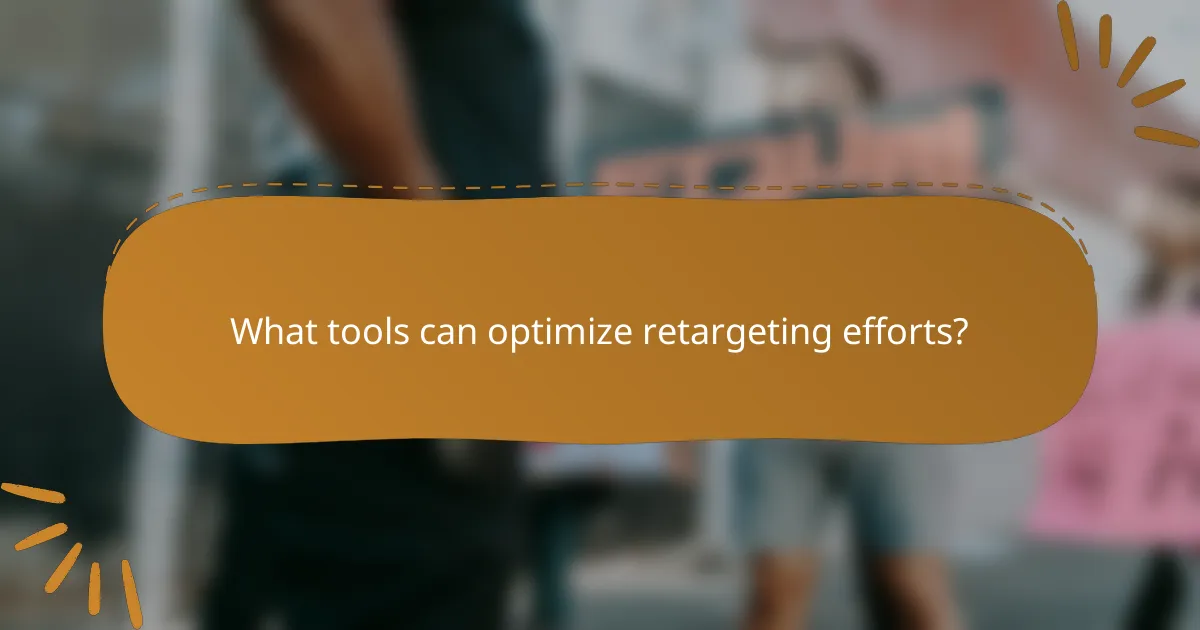
What tools can optimize retargeting efforts?
Several tools can significantly enhance retargeting efforts by allowing businesses to reconnect with potential customers who have abandoned their carts. Utilizing these tools effectively can lead to improved conversion rates and increased e-commerce growth.
Google Ads for retargeting
Google Ads offers robust retargeting capabilities through its Display Network and Search Ads. By placing tracking cookies on users’ devices, businesses can serve tailored ads to those who previously visited their site, reminding them of products they showed interest in.
To optimize retargeting with Google Ads, consider segmenting your audience based on their behavior, such as pages visited or time spent on the site. This allows for more personalized ad content, which can increase engagement and conversion rates.
Facebook Ads Manager for audience segmentation
Facebook Ads Manager provides powerful tools for audience segmentation, enabling businesses to retarget users based on their interactions with the brand on Facebook and Instagram. This includes users who have engaged with posts, visited the website, or added items to their cart.
Utilizing custom audiences and lookalike audiences can enhance the effectiveness of your retargeting campaigns. For example, creating a lookalike audience based on previous purchasers can help you reach new potential customers who are likely to convert.
AdRoll for multi-channel retargeting
AdRoll specializes in multi-channel retargeting, allowing businesses to reach customers across various platforms, including social media, email, and display ads. This comprehensive approach ensures that your brand remains visible to potential customers wherever they spend their time online.
To maximize the effectiveness of AdRoll, utilize its dynamic ad features to automatically generate personalized ads based on user behavior. Additionally, consider setting up frequency caps to avoid overwhelming users with too many ads, which can lead to ad fatigue.
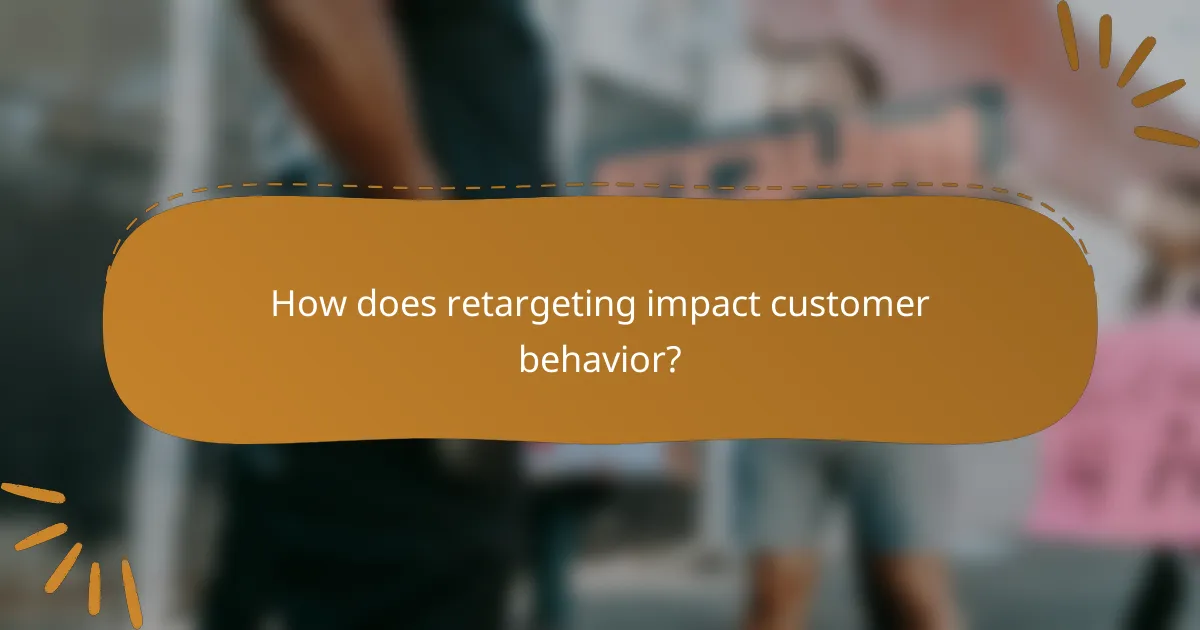
How does retargeting impact customer behavior?
Retargeting significantly influences customer behavior by reminding potential buyers of products they showed interest in, thereby increasing the chances of conversion. This strategy leverages online ads to engage users who have abandoned their carts, enhancing brand visibility and encouraging purchase completion.
Increased brand recall and recognition
Retargeting ads keep your brand top-of-mind for consumers who may have forgotten about their initial interest. By repeatedly displaying relevant products, brands can reinforce their identity and offerings, making it more likely that customers will recognize and remember them when they are ready to buy.
For instance, a customer who viewed a pair of shoes but left the site without purchasing may see ads for those shoes across various platforms. This consistent exposure boosts brand familiarity, which is crucial in a competitive e-commerce landscape.
Higher likelihood of purchase completion
Retargeting directly increases the likelihood of completing a purchase by reminding customers of items they left behind. When users see ads for abandoned carts, it prompts them to revisit the site and finalize their transactions.
Research suggests that retargeted customers are significantly more likely to return to a website and complete their purchases compared to those who do not receive such reminders. This can lead to conversion rates that are notably higher, often in the range of 10-30% for retargeted users.
Influence on customer decision-making
Retargeting can sway customer decision-making by providing timely reminders and incentives, such as discounts or free shipping offers. These strategies can help alleviate any hesitation customers may have about making a purchase.
For example, a retargeting ad might include a limited-time discount on an item left in the cart, creating a sense of urgency. This tactic not only encourages immediate action but also helps customers feel more confident in their purchasing decisions.
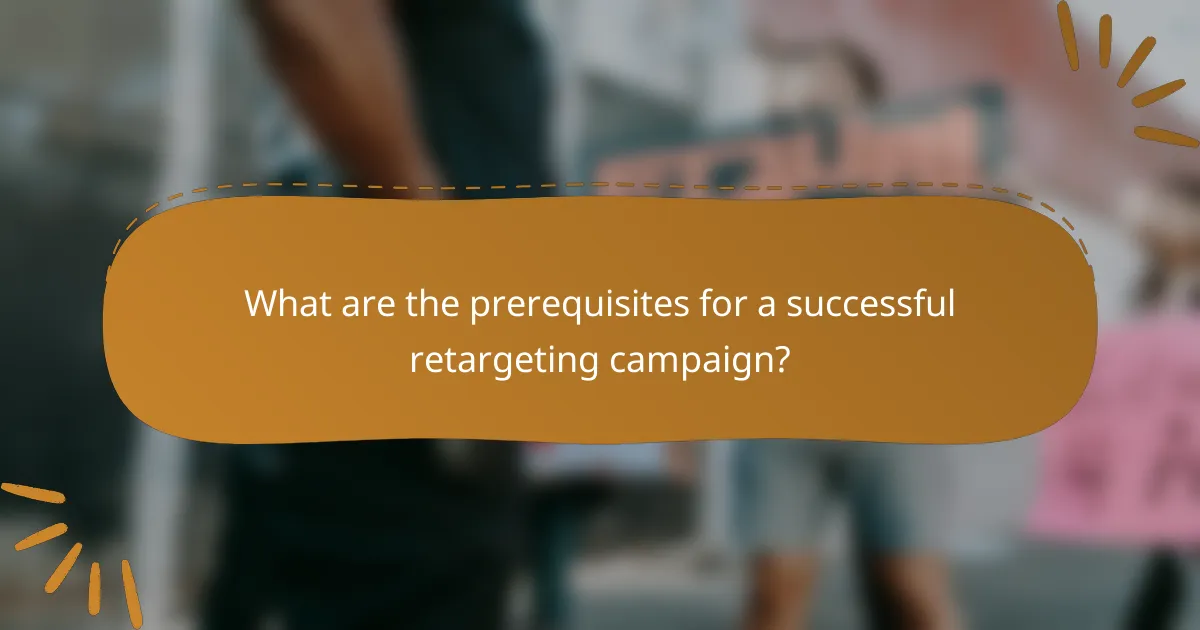
What are the prerequisites for a successful retargeting campaign?
Successful retargeting campaigns require a clear strategy, effective tracking systems, and well-defined audience segments. These elements ensure that your efforts to recover abandoned carts and engage potential customers are both efficient and impactful.
Clear understanding of customer journey
A thorough understanding of the customer journey is essential for effective retargeting. This involves mapping out each stage from awareness to purchase, identifying key touchpoints where customers may drop off. By recognizing these moments, you can tailor your retargeting efforts to address specific concerns or barriers that lead to cart abandonment.
For instance, if customers frequently abandon their carts after viewing shipping costs, consider highlighting free shipping offers in your retargeting ads. This targeted approach can significantly improve conversion rates.
Effective tracking and analytics setup
Implementing robust tracking and analytics is crucial for monitoring customer behavior and campaign performance. Use tools like Google Analytics or specialized e-commerce platforms to gather data on user interactions, including page views, time spent on site, and cart abandonment rates. This data will inform your retargeting strategies and help you optimize your campaigns.
Ensure that your tracking setup includes conversion pixels and event tracking to capture specific actions. Regularly analyze this data to identify trends and adjust your retargeting tactics accordingly.
Defined audience segments for targeting
Creating defined audience segments allows for more personalized and effective retargeting. Segment your audience based on behaviors, such as those who viewed specific products, added items to their cart, or completed a purchase. This granularity enables you to craft tailored messages that resonate with each group.
For example, you might create a segment for users who abandoned their carts without completing a purchase and send them a reminder email with a discount code. This targeted approach can lead to higher engagement and recovery rates.
